Text
Number Call by Nagisa Furuya, reviewed by Jay Sapinski
Nagisa Furuya’s newest manga volume, Number Call (Kodansha Comics, 2024) is a sweet high school meet-cute romance. The story centers around Eito Tachibana who despises how his name is associated with the number eight meeting Tomoya Hatta whose nickname is Hachi, the Japanese word for the number eight. Initially drawn together by their names having a connection, they eventually find themselves chasing after each other. The story is certainly cute and heartwarming, but the plot delivers the elements of a romance in a way that is almost too straightforward. Although there is romantic tension between Eito and Hachi, it never really felt like there was a threat to their bond. Even in a wholesome story, there should still be stakes for the choices that the characters make. Nevertheless, I found myself turning to the next page to discover how they would grow closer.
Additionally, unlike many other BL manga, this one features a story that stays far from depicting toxic relationships and the fetishization of gay people that plague the genre. Eito and Hachi meet when Eito’s test papers are knocked out of his hand and float out the window where Hachi picks them up. After Eito runs down to get them, they have a short exchange:
Hachi: You got an 88 in Japanese history. Eito Tachibana.
Eito (thinking): Why’d he read that out loud?
Hachi: Haha. You got an 88 and you’re [sic] name’s Eito? It’s like a pun.
Eito: I guess…
Eito (thinking): Uh, did he stick around to just say that? Is he making fun of me?
Hachi: I thought it might blow away again if I put it down.
Eito: Okay…
Hachi: Plus, I can kind of relate.
From chapter 1: Call 1
The interaction between the two sounds completely natural for two high schoolers who don’t really know each other. There is no stalker behavior, coercion, or bizarre pairings for the sake of reader fetishes. It’s all very cute, wholesome, and heartwarming. It’s great to see more BL manga representing gay love as being completely normal.
That being said, the story would have been taken to the next level had there been more build towards their relationship. It’s difficult to tell why Eito or Hachi hold affection for each other or how their shared experiences contribute to them liking each other. Show us a date, a stolen moment in a classroom—anything that would solidify the reasons why they like each other beyond their names relate to the number eight. The times when they are alone together don’t give readers enough information about what makes Eito or Hachi interesting and attractive in the eyes of the other.
Number Call is an excellent addition to BL manga as a whole. Steering away from the problems of the BL genre, it highlights how cute and sweet romance can be. Hopefully, this isn’t the last wholesome BL meet-cute to grace our shelves.
An advance copy of this volume was provided in return for an honest review.
Number Call becomes available on March 12th, 2024. Pre-order Number Call here.
~
Jay Sapinski (they/them) is a college student studying English. They are an editor of their college's literary magazine as well as a fiction editor of miniskirt magazine. Jay loves Japanese culture and Japanese style media and consumes it whenever possible.
#reviews#number call#nagisa furuya#manga#recommended#review#jay sapinski#slice of life#romance#school life#stories#story#completed#one shot
0 notes
Text
Kubera by Currygom, reviewed by Jay Sapinski
What's it like to share a true name with a god? What power does it hold, and what effect does it have on a person's destiny? In Kubera (WEBTOON, 2014—present), the protagonist presses through the difficulties of sharing the name Kubera with the god of the same name. True names have power and can put an individual in danger if it's an important name. In particular, the power of the name Kubera can be concentrated the fewer people who have it, so the Kubera that readers follow goes by the name Leez. Leez becomes the sole survivor of her village when a Sura (an ageless being who has both human and animal forms as well as a powerful offensive skill called a transcendental) destroys it in entirety. After seeing the destruction of everything that she's ever known, Leez, along with a mysterious magician Asha Rahiro, set out on a quest for revenge.
Initially, the story is populated with moments of levity, despite the tragedies. This disappears as the story progresses—there becomes very little to laugh about. Every character, even those who could be characterized as antagonists, are victims of at least one tragic event that shapes their goals. Every individual is the protagonist in their own story, believing that they are acting in the best interests of themselves and those close to them. In this way, the characters of Kubera are truly life-like.


Episode 2: A Girl With a God's Name (2), Leez coming across a magical stranger while she's forging for mushrooms.
Seemingly because of that life-like complexity, the story has an insanely complicated plot that requires remembering details mentioned in episodes long before the current one in order to have the full impact. Especially because of the weekly format, it's easy to forget the bits that didn't seem important previously. Mixed in with time travel and multiple planets, realms, and universes, and it's difficult to not get lost. Kubera demands that readers think deeply about what happens to characters as well as their motivations for their actions. The barrier of understanding is high, but it is well worth the emotional rewards. It's a puzzle, but the pieces are always there.
Kubera is on episode 545 as of this review, and it updates on Mondays.
~
Jay Sapinski (they/them) is a college student studying English. They are an editor of their college’s literary magazine as well as a fiction editor of miniskirt magazine. Jay loves Japanese culture and Japanese style media and consumes it whenever possible.
#reviews#kubera#webtoon#web comics#recommended#series review#currygom#review#jay sapinski#fantasy#time travel#stories#story#ongoing#serializing#serial story
2 notes
·
View notes
Text
Umibe no Étranger by Studio Hibari, reviewed by Jay Sapinski
Most shounen ai leave a certain distaste that comes from creepy or toxic portrayals of relationships, but Umibe no Étranger (Funimation, 2020) eschews these common plot points. The growth between Mio and Shun is naturally developed, and even in the conflict, we see them gradually draw closer.
It begins with Shun noticing Mio frequently sitting by himself at the beach. This is unusual in their small island town where people tend to be well integrated into their community. Shun approaches Mio, giving him food from the shop that he works at, and from here, they encounter each other more where each learn new things about the other. Just as they become close enough to be friends, Mio announces that he has to leave for the mainland. Three years later, Shun and Mio reconnect on the island, though so much has changed and the emotions between the two are fraught with conflict.
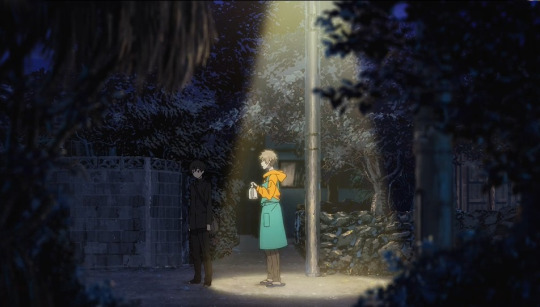
Shun giving Mio some leftover food after seeing him being alone at the beach frequently.
Umibe no Étranger is better than nearly all shounen ai, partially due to the fact that the bar is so low at the current moment. While Mio and Shun's relationship isn't without its flaws, it moves away from the principle problems that often plague shounen ai anime: stalking and disrespect of boundaries. For this, it deserves some praise. Let's get some more normal, cute plotlines like the shoujo classics Kimi ni Todoke or Fruits Basket, yes? Or, if the story must be serious and focused on the LGBTQ+ elements, like Hourou Musuko?
Umibe no Étranger attempts to cover those LGBTQ+ elements, but it falls short. The characters don't spend nearly enough time grappling with the consequences of their actions, and there isn't nearly enough time spent with Mio's backstory related to how others treated him for being gay for us to really understand how it has affected him. It merely touches on the topic before moving on, leaving too much unsaid. There is too much ground to cover in too little time.

Shun and Mio hugging after Mio ran away.
Speaking of time, the three year time skip is jarring. One second we see Mio tell Shun that he's leaving for the mainland and the next second we see Mio return. There is little suggestion about how Shun or Mio were affected by the other's absence. It's shocking that Mio returns at all, despite their farewell interaction. While the characters experience the separation between them, as viewers, we do not. Whether they suffered or not during this period is unknown. Did it affect them? I don't know.
Nevertheless, the core of the romance is crafted well. Shun and Mio make a complicated but caring pair. They act with the best interests of the other in mind, even when they make rash decisions. They come across as believable in the context of their situation.
A good shounen ai movie.
Umibe no Étranger is a 58 min anime film.
~
Jay Sapinski (they/them) is a college student studying English. They are an editor of their college’s literary magazine as well as a fiction editor of miniskirt magazine. Jay loves Japanese culture and Japanese style media and consumes it whenever possible.
#reviews#umibe no etranger#the stranger by the shore#anime#animation#recommended#series review#studio hibari#review#jay sapinski#bl#boys love#boy's love#shounen ai#romance#slice of life#completed#movie
0 notes
Text
Ao no Flag by KAITO, reviewed by Jay Sapinski
Curling up with a cutesy rabu rabu manga somehow just makes the world a bit better. Ah, a love story that's just the right amount of tense to keep me reading but not so tense as to leave me feeling like love is a struggle. Ao no Flag (Shounen Jump+, 2017—2020) is just this: a sweet high school love story. Don't mistake this for a simple story though; it delves deep into the complexity of relationships and friendships.
At first, it looks like Taichi and Futaba will be pushed together, but Futaba quickly reveals that she likes Taichi's friend, Touma. After grappling with feelings of his own, Taichi decides to help Futaba. What neither of these two realize is that Touma is gay and in love with Taichi. This is only noticed by Futaba's friend, Masumi, who is in love with her. The complications from this love square grows as they become more connected with each other.


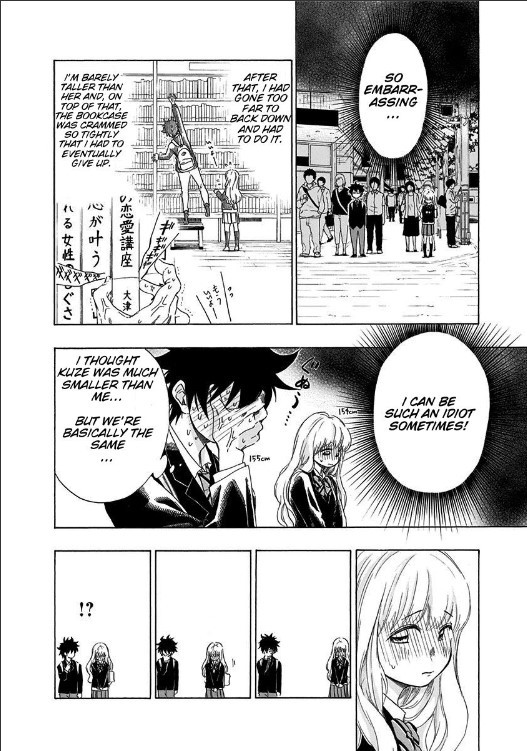
Chapter 1: The 1st Conversation, Taichi meeting Futaba.
While most of the story is excellently paced, the ending is a bit rushed. The last two chapters could be their own arches, explaining further the choices that the main characters made. Instead, most of it is condensed into summary, leaving me feeling like I missed out on some defining moments of the characters.
Despite this though, the story is well worth reading as it skips the troupe-y formulas that often get recycled in the romance genre. It critically looks at complicated relationships while still remaining generally warm.
Ao no Flag is completed at 54 chapters as of this review.
~
Jay Sapinski (they/them) is a college student studying English. They are an editor of their college’s literary magazine as well as a fiction editor of miniskirt magazine. Jay loves Japanese culture and Japanese style media and consumes it whenever possible.
#reviews#ao no flag#blue flag#manga#recommended#series review#KAITO#shounen jump+#review#jay sapinski#slice of life#romance#school life#shounen#stories#story#completed#serialized
4 notes
·
View notes
Text
Dear WEBTOON, What's Up With Daily Pass? by Jay Sapinski
Within the passed few years, web comic publisher, WEBTOON, has instituted Daily Pass, a system where readers must unlock a new episode every day in order to read. If a reader wants to read more episodes, they must exchange coins for access (about 30 cents per episode). It began with completed titles, but more recently, it has spread to serializing titles (called Daily Pass Originals). These types of serializing titles also require the last three episodes to be exchanged using coins.
Once limited to one every few months, Daily Pass Originals have become commonplace, a few debuting every month. They're nearly always Korean web comics licensed for English translation. The reception from readers to this new change is decidedly negative, especially from those who prefer to binge read. That, of course, is possible if one is willing to unlock an episode every day. But this points to a wider trend that WEBTOON is employing.

An example of a recent Daily Pass Original.
The platform is looking to expand the opportunities that it has to get readers to spend money. This in of itself is a normal practice for a business to employ, but as a reader, this is a frustrating situation. What's stopping WEBTOON from removing the Daily Pass function all together and putting everything behind a paywall? There isn't anything but the fact that Daily Pass Originals fairly consistently flop. The newest titles don't pass 100,000 subscribers or one million views within a week (a good indication of passable popularity).
(This is happening in some fashion to nearly all debuts, even if they aren't Daily Pass Originals, and even if they're from established creators, but that's a conversation for another day).
If barely anyone is reading it, it's not making any sort of money. I suspect putting everything behind a paywall would cause a mass flight of readers from the platform that WEBTOON should be desperately trying to avoid. After all, people who disliked Lezhin's and Tappytoon's paid models for reading web comics turned to WEBTOON. If WEBTOON turns into the same as those platforms, what's stopping readers from jumping to the next platform that offers a more enjoyable reading experience? As much as I hate ads, I'm tempted to say that forcing a reader to view an ad beforehand à la YouTube is a better path to go upon. People will view the ad, especially if they know that the creator benefits from it. They will not always buy coins, even if they know that the creator benefits from it.
In addition to the frustrating experience of switching from an ad driven model to a more or less paid model, there are also some questionable UI decisions that make Daily Pass Originals irritating. There's no function for buying the entirety of a title or at least mass buying episodes. WEBTOON, you mean to say that if I read the free episodes and decide that I'm going to read the entire thing, I can't frontload all of the coins to read every available episode? I have to click each episode one by one and buy them? Frustrating. Especially if I start reading a title months after it debuted and there are potentially over a hundred episodes available. Let me select particular episodes, as many as the amount of coins I have allows, and all of the available episodes! I get as many episodes as I want in one fell swoop. I see the confirmation message once. I can read everything without interruption.
A less painful reading experience pushes the story to the forefront, making readers more capable of consuming more stories, expanding the reach of the platform. Make it easier for us to buy episodes. Make it easier for us to access episodes. Make it easier for us to read stories.
~
Jay Sapinski (they/them) is a college student studying English. They are an editor of their college’s literary magazine as well as a fiction editor of miniskirt magazine. Jay loves Japanese culture and Japanese style media and consumes it whenever possible.
10 notes
·
View notes
Text
Long Live The Queen by Hanako Games, reviewed by Jay Sapinski
Long Live The Queen (Hanako Games, 2012) is a management visual novel with a complex skill building system and a wide range of outcomes and choices. You slide into the shoes of the Crown Princess Elodie of Nova as she navigates politics, war, and love following her mother's death. Because she's too young to ascend the throne (only 14 years old!), you have to survive 40 weeks until she turns 15 and is able to become queen.
This, as it happens, is much harder than one would think. Threats are around every corner. Your first run (but also most likely your next few runs) will undoubtedly end with Elodie perishing in any one of the startling 11 ways to kick the bucket.

The screen that the player returns to after each week.
The core of the game is selecting two classes to take every week, keeping in mind the skills that you want to build as well as Elodie's mood, which affects how well she learns. This is followed by reading a short event where, if applicable, skill checks are displayed, making it easier to understand where you can make different choices in your next run. During the event section, you will sometimes be able to make a choice about an action that Elodie can take. You then select a location for Elodie to visit, helping to alter her mood to suit your needs. Although repetitive in theory, this loop is a safe and enjoyable circle, allowing you a structure from which to impact the story.

The menu showing how well Elodie understands or is skilled in a particular topic.
The story is paced well with excellently crafted dialogue that distinctly sounds like each character. The choices in event sections make sense and aren't polar extremes without reason. Skill building management as well as mood management is crucial to both Elodie's survival and your ability to explore the various plotlines available. Certain events are fixed but many require you to pass a particular skill check to begin. It is, without a doubt, worth replaying to search for these hidden plotlines.

Elodie responding to another character during an event section.
Certain events are influenced by foreign policy decisions, and while fine in of itself, this could be aided by an easily accessible map of the region as well as a family tree (there is none in game but Hanako Games has posted a map on their forums and fans have created family trees). Understanding the motivations of the nobility is an important factor in making appropriate choices that protect Elodie from their plots. Even if Elodie doesn't know this information from the start, if a player passes certain skill checks, the information can be added to these diagrams.
Long Live The Queen is an excellent management visual novel, hitting all of the major requirements to be both a good read and a fun game.
Long Live The Queen can be purchased for $10 through the Hanako Games website as well as through Itch.io and Steam.
~
Jay Sapinski (they/them) is a college student studying English. They are an editor of their college’s literary magazine as well as a fiction editor of miniskirt magazine. Jay loves Japanese culture and Japanese style media and consumes it whenever possible.
#reviews#long live the queen#visual novel#vn#recommended#hanako games#review#jay sapinski#management game#stories#story#completed
5 notes
·
View notes
Text
Your Throne by SAM, reviewed by Jay Sapinski
Your Throne (WEBTOON, 2020—present) presents Medea Solon and Psyche Callista, two aristocrats, in conflict over the highest seat that the Vasilios Empire can offer to rising female nobles: Crown Princess. Medea was set to win the position as part of a contest to determine who would become the Crown Princess, but the Crown Prince selects Psyche instead. Feeling betrayed, Medea works to enact revenge upon Psyche. However, on the day of the Yearly Prayer, the divine swaps Medea's and Psyche's bodies, leaving both of them in unfamiliar situations and roles.

Episode 1: The Two Ladies of Rumor (1), Medea taking notice of two minor nobles gossiping about her.
Medea adapts easily to her new reality as expected of a person who is portrayed as cool, calculating, and manipulative. Putting on a range of emotions and faces, even ones that she doesn't normally use, are child's play. Psyche's adaption, however, is riddled with mistakes, leaving many of Medea's (now Psyche's) attendants wondering if she is who she says that she is. This is also expected as Psyche is depicted as naïve, honest, and caring. She wears her heart on her sleeve and everyone can see the drastic change in behavior in "Medea".


Episode 1: The Two Ladies of Rumor (1), Medea killing a soldier in the service of Psyche.
Due to circumstance, Medea and Psyche are forced into aiding each other, and over time, they learn that the other has qualities that are important to being a ruler. Indeed, it is crucial that Medea understands that her manipulation is to lesser effect if she is so cruel that even those closest to her fear her. By the same token, Psyche learning that the people around her may be working to undermine her position and hurt her allows her to protect herself and those around her.
In this way, Medea and Psyche, although initially characterized in a simple fashion, become more complex and real people, shaped by the situations that they are thrust into.

Episode 2: The Two Ladies of Rumor (2), Psyche preparing for the ritual on the day of the Yearly Prayer.
Your Throne starts from a position that many stories have tread, but it builds characters that stand on their own, becoming understandable and loveable in their own ways.
Your Throne is on episode 126 as of this review, and it typically updates on Saturday but is on hiatus.
~
Jay Sapinski (they/them) is a college student studying English. They are an editor of their college’s literary magazine as well as a fiction editor of miniskirt magazine. Jay loves Japanese culture and Japanese style media and consumes it whenever possible.
#reviews#your throne#webtoon#web comics#recommended#series review#SAM#review#jay sapinski#political intrigue#stories#story#ongoing#serializing#serial story
3 notes
·
View notes
Text
Kiznaiver by studio Trigger, reviewed by Jay Sapinski
Kiznaiver (Crunchyroll, 2016) is a emotional journey that has an odd shift towards the end of the series. The story centers around a group of seven (Katsuhira Agata, Chidori Takashiro, Niko Niiyama, Yoshiharu Hisomu, Hajime Tenga, Honoka Maki, and Tsuguhito Yuta) who are abducted and forced to participate in an experiment around emotional connection called the Kizna System. After Noriko Sonozaki, the head of the experiment, demonstrates of how pain is distributed among the members, they are threatened into sharing their secrets with each other, pushing them to bond.
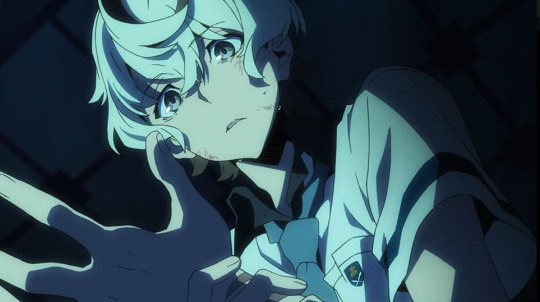
Episode 1: Sometimes, a Bond Can Bloom from the First Day Eye Contact Is Made, Katsuhira seeing his scars from the Kizna System for the first time.
The execution of the show's concept is excellent at first, but when it shifts to the connection between Noriko and Katsuhira, the plot loses focus. The first two-thirds of the anime clearly develops the main characters, and by forcing them together, we see the group grow closer and depend on each other when they have difficulties. We become invested in their lives, and when there's friction between members, we yearn for them to resolve it.
But when the story switches to Noriko and Katsuhira's past connection, it's disorientating and frustrating, leaving leaving viewers wondering what the point of the everything preceding the shift. It's obvious that their past is related to the present Kizna System, but as Noriko is an outsider to the group, we aren't so invested in her situation with Katsuhira. Additionally, attempts at making her a sympathetic character are met with resistance on my part—as far as I'm concerned she's the villain, and she isn't afforded enough time to convince me otherwise. In general, this arch isn't given the screen time it needs in order to draw viewers into it.

Episode 10: You Knew Very Well That Your Romantic Feelings Might Be Unrequited, Right?, Katsuhira, Niko, and Yoshiharu dancing in a circle while holding hands.
Although the end is a departure from the rest of the show, it's still worth watching as the beginning two-thirds features strong character growth and bonding. Its ideas surrounding what it means to understand others and how to achieve connections are also worth noting.
In the end, there is no bonding without vulnerability but forcing it perhaps isn't the path to understanding each other.
Kiznaiver is a single season complete at 12 episodes as of this review.
~
Jay Sapinski (they/them) is a college student studying English. They are an editor of their college’s literary magazine as well as a fiction editor of miniskirt magazine. Jay loves Japanese culture and Japanese style media and consumes it whenever possible.
#reviews#kiznaiver#anime#animation#recommended#series review#trigger#review#jay sapinski#drama#action#romance#sci fi#completed#studio trigger
1 note
·
View note
Text
unOrdinary by uru-chan, reviewed by Jay Sapinski
unOrdinary (WEBTOON, 2016—present) is an engaging story that builds upon the action/superhero model to consider questions about power, community, and individual responsibility. The story follows John as he navigates a world where everyone except him has superpowers. In his school, the powerful can do anything they want because they have the abilities to enforce it. The authorities of the school stay out of the fighting for the most part, meaning that the top students are the de facto authorities. John has one friend, Seraphina, who is the most powerful student, and she shields John from the violence, but she gets suspended, leaving him mostly defenseless.
Initially, the story makes fun of the inane things the powerful fight over as a means of drawing readers into the world that John inhabits, but it quickly reveals that the powerful are often cruel to those weaker than them for seemingly no reason. When given the opportunity to hurt someone for a perceived slight, they take it in full, leaving victims with bruises and broken bones as well as mental anguish and fear.

Prologue, John crying over not getting a slice of cake because much stronger people are fighting over the last slice.

Episode 29, John getting beat up by someone with enhanced speed and strength.
The arrangement of the panels, dialogue, and captions guide the reader's eye towards the most important aspects of any particular scene. In Episode 33 (excerpted below), one of the school's most powerful individuals, Remi, attempts to help John pick up some papers that he dropped, but she shows concern which reminds John of a person in his past, causing him to lash out.
The first panel excerpted directs readers to Remi's perspective. The three black lines next to her face demonstrates that she's noticing what's in the next panel. In case it wasn't clear, there is a pink bubble clarifying that Remi sees that John has been hurt.
In the next panel, we see Remi turn away from her friend. Because we've seen that Remi is looking at John, we know that Remi is going to him.
The following panel recenters us into John's perspective and confirms that Remi has approached John.
The next panel shows Remi pick up a sheet of paper, and we know that this person is Remi because we can see her pink hair in the corner. There's a spikey figure showing that John is surprised by this intervention.
By this point, Remi's speech has been established as pink bubbles, so the introduction of a a green overlay on part of her speech suggests that John is comprehending Remi's speech as someone else's.
The next panel shows John's expression change to anger as he looks up. We see that there's another bit of Remi's dialogue that John is confusing for someone else.
This is followed by a somewhat grainy image of a green haired individual, confirming that John believes that Remi is this person from his past.
Then we see John's reaction to what he believes that he sees, which is shock and anger. The dialogue that follows is in a spikey speech bubble and the text is in all caps, demonstrating that the green haired person had previously harmed him, and because he mistakes Remi for that person, she is on the receiving end of his fury.
The final panel of this excerpt depicts John slapping away Remi's hand. The line effects not only direct the reader to Remi and John in the center, but also demonstrate the bystanders' shock at John's reaction.


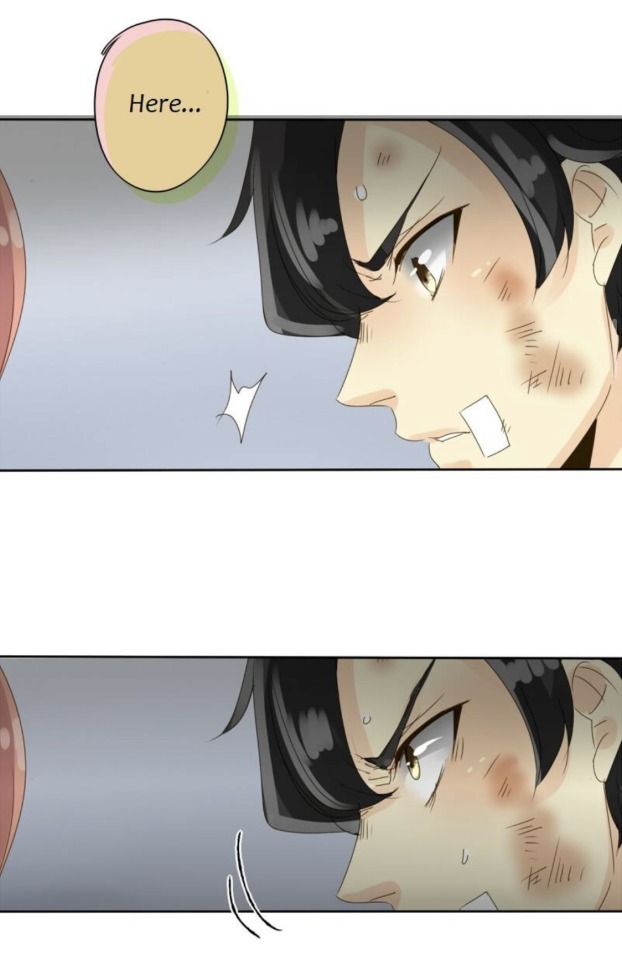

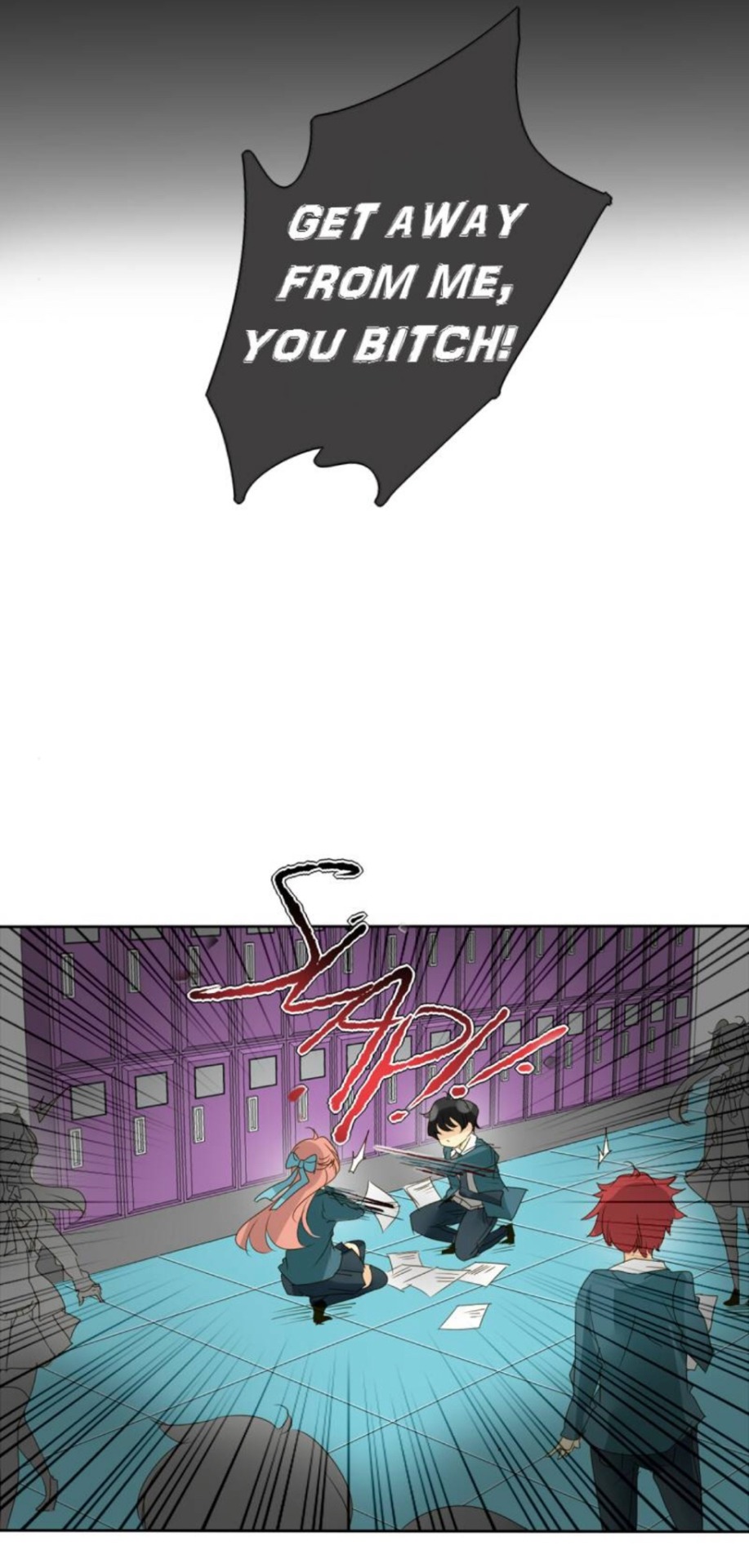
Episode 33, John slapping away Remi after remembering someone from his past.
unOrdinary builds a world that leaves us wondering about the responsibilities of those in power to the ones weaker than them as well as the function of community in protecting those weaker individuals. It features engaging storytelling, blending writing with art, allowing readers to be immersed in a world unlike our own in many ways but similar in others.
unOrdinary is on episode 270 as of this review, and it updates on Thursdays.
~
Jay Sapinski (they/them) is a college student studying English. They are an editor of their college's literary magazine as well as a fiction editor of miniskirt magazine. Jay writes in all genres but focuses on fiction. As of now, they are working on pieces investigating love and death.
#reviews#unordinary#webtoon#web comics#recommended#series review#uru-chan#review#jay sapinski#superheroes#superhero#stories#story#ongoing#serializing#serial story
4 notes
·
View notes